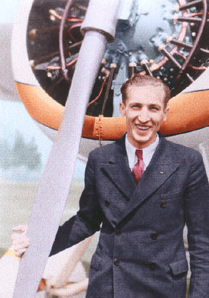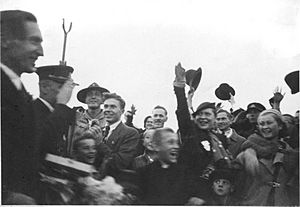Feliksas Vaitkus facts for kids
Quick facts for kids
Feliksas Vaitkus
|
|
|---|---|
 |
|
| Born | June 20, 1907 |
| Died | July 25, 1956 (aged 49) |
| Nationality | Lithuanian American |
| Education | University of Chicago |
| Spouse(s) | Marta Brotz |
| Awards | Order of Vytautas the Great, III class (1935) |
| Aviation career | |
| Air force | |
| Battles | World War II Korean War |
| Rank | Lieutenant colonel |
Feliksas Vaitkus (1907–1956), also known as Felix Waitkus, was a brave pilot. He was born in America but had Lithuanian roots. He became famous for being the sixth person to fly alone across the huge Atlantic.
Contents
Early Life and Training
Feliksas Vaitkus was born in Chicago, USA. His parents came from Lithuania in 1904. They settled in a neighborhood in Chicago known for its Lithuanian community.
In 1928, Feliksas joined the U.S. Army. He trained hard to become a pilot. After his training, he became a second lieutenant in the United States Army Air Corps. In 1931, he joined the reserves as a first lieutenant. He then returned to civilian life. He worked with his father-in-law at a flying school in Kohler, Wisconsin.
The Lituanica II Project
After a sad airplane crash involving another Lithuanian flight called Lituanica, people in the Chicago Lithuanian community wanted to try again. They decided to raise money for another flight across the Atlantic. Even though it was during the Great Depression, a time when money was scarce, they collected enough funds.
They bought a new, faster airplane. It was a Lockheed Vega, similar to the one used by famous pilots like Wiley Post and Amelia Earhart. On April 22, 1934, the plane was named Lituanica II. The pilot originally chosen for the flight quit. So, the organizers asked Feliksas Vaitkus to take on the challenge. He bravely accepted.
The flight was delayed until 1935. The plane needed changes to make it stronger. Extra fuel tanks and a more powerful engine were added. New tools were also installed. These included a special propeller and a radio compass. These tools were not available on the first Lituanica plane. Lituanica II was tested many times to make sure it was ready.
The Transatlantic Flight
Vaitkus arrived in New York in May 1935. No pilots had been able to fly across the Atlantic that year. The weather was just too bad. He had to wait for four months for a good weather report.
Finally, on the evening of September 20, he got good news. The weather along his route had improved. The next day, September 21, at 6:45 AM, Lituanica II took off for Europe.
Vaitkus faced terrible weather during his flight. He flew through rain, fog, and ice. He had to rely mostly on his new radio compass to navigate. He often saw ice forming on the wings. He would fly lower until the ice melted. An Irish radio station helped him a lot. They gave him hourly updates. He learned that Dublin and other areas were foggy. He knew he couldn't reach Kaunas because of low fuel. After 23 hours of fighting the bad weather, he decided to land in Ireland.
He found an open field in Cloongowla, near Ballinrobe, County Mayo. He landed there, and the plane was badly damaged. But Vaitkus was safe and uninjured! Lituanica II was packed up and sent to Lithuania for repairs. Vaitkus traveled by ship and train to Kaunas. He received a hero's welcome there.
Feliksas Vaitkus was the only pilot to fly across the North Atlantic in 1935. Even though he landed in Ireland, he made history. He was the sixth pilot to fly solo across the Atlantic.
Later Life and Legacy
In 1940, Feliksas Vaitkus was called back to active duty. He became the chief test pilot at the Boeing Aircraft Company in Seattle. He tested many B-17 and B-29 bombers. He was called back again to serve in the U.S. Air Force during the Korean War.
Feliksas Vaitkus died from a heart attack in Wiesbaden, Germany, on July 25, 1956. He was 49 years old. His body was brought home and buried in Sheboygan, Wisconsin. At the time of his death, he held the rank of lieutenant colonel.
Images for kids



